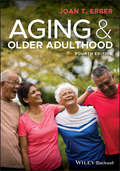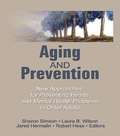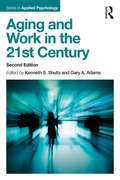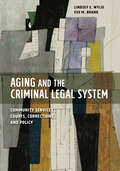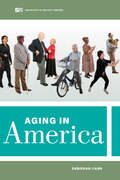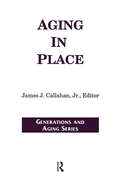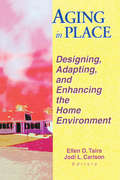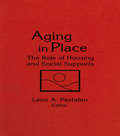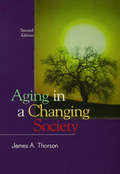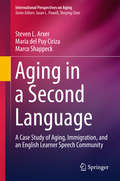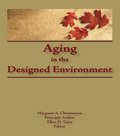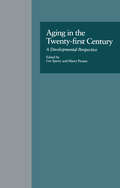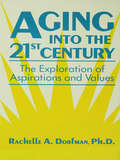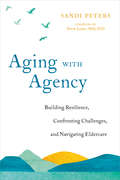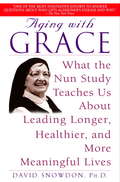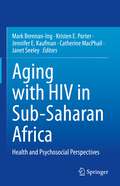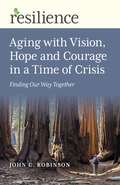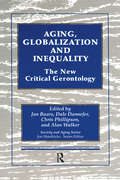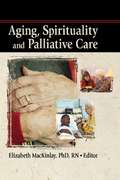- Table View
- List View
Aging and Older Adulthood (Wiley Desktop Editions Ser.)
by Joan T. ErberReflects the most important theoretical foundations and research directions concerning aging and older adulthood This authoritative volume provides the latest insights into, and theoretical interpretation of, our understanding of the human aging process. Newly updated and revised, this edition of the well-established student textbook offers relatable scenarios that touch upon real-world issues faced by older adults and their families. The book explains how research studies attempt to answer questions of both theoretical and practical importance as they relate to aging and older adulthood, and it explains the hypotheses and findings of the studies in a manner that is comprehensible to readers of all levels of research experience. Aging and Older Adulthood begins by describing the demographic characteristics of the older population, and follows with a chapter on theoretical models that apply to the study of adult development and aging, as well as approaches commonly taken to conduct research and ethical concerns involved in the study of this group. It then offers a series of chapters exploring biological aging, sensation perception and attention, memory, intellectual functioning, cognition and real-world problem-solving, personality and coping, social interaction and social ties, lifestyles and retirement, mental health and psychotherapy, and death and bereavement. The final chapter looks at aging in the future. Each chapter includes fully updated research findings, as well as new and expanded coverage of concepts and ideas in areas such as neuroscience, and diabetes. New edition of a highly respected text exploring our contemporary understanding of a broad range of topics related to older adulthood and the psychology of aging Offers thematic treatment of core issues including health, sensory perception, memory, intellect, social interactions, employment and retirement, and mental health Uses a dual lens of two models – the selective optimization with compensation model and the ecological model – to provide cohesiveness to the presentation of both theoretical and applied material Introduces each chapter with a relevant real-world scenario and refers back to it throughout the chapter Includes pedagogical feature boxes that reflect current understanding of contemporary issues in the field as well as key points and issues for further discussion Aging and Older Adulthood, 4th Edition is an excellent text for upper division undergraduate and graduate courses focusing on the older adulthood and aging, the psychology of aging, gerontological studies, and lifespan development.
Aging and Prevention: New Approaches for Preventing Health and Mental Health Problems in Older Adults
by Robert E HessRenowned specialists on aging explore the meaning of prevention and provide practical information about programs and services for the elderly. Interesting chapters focus on the prevention of long-term care institutionalization, alternative health delivery systems, informal support networks, and the prevention of domestic neglect and abuse of elderly adults.
Aging and Skilled Performance: Advances in Theory and Applications
by Wendy A. Rogers Arthur D. Fisk Neff WalkerThe term "skill" encompasses an array of topics and issues. For example, individuals are skilled in a variety of domains such as chess, typing, air traffic control, or knitting; researchers study skill in a variety of ways, including speed of acquisition, accuracy of performance, and retention over time; and there are a variety of approaches to the study of skill such as computer modeling or experimental analysis. Contributing to the understanding of whether, how, when, and why skills may decline as a function of age is the goal of this volume. This book is based on the Aging and Skill Conference sponsored by the Center for Applied Cognitive Research on Aging. The broad focus of the conference was to discuss cognitive theories underlying age-related skill acquisition, transfer, and retention and to discuss applications of these theories to such issues as age-adaptive training, compensatory strategies and devices, and utilization of new and existing technology. The contributors were asked to discuss the cognitive theory relevant to their topic, explain how the theory informs the field about aging, examine where gaps exist among general cognitive theory in this area and theories of aging, and demonstrate the practical relevance of the theory to enhancing or enabling activities of daily living--for work, home, or leisure--for older adults. This is the first book to focus exclusively on aging and skill. It covers a range of abilities, provides the theoretical basis for the current status of age-related differences in skill, and offers direct evidence of the applicability of research on proficiency to aspects of daily living. Each chapter was written either by an expert in the field of aging, or by an expert in the field of skill--many expert in both areas.
Aging and Time: Multidisciplinary Perspectives, Illustrated Edition
by Jan BaarsThe aim of this volume is to revitalise the debate about the concepts of time implicit in the study of aging. The many problems related to aging and the aged put an enormous pressure on the gerontological community to come up with practical applications and solutions. In considering research findings, we must keep in mind the basic assumptions that shape and influence even the most obvious statements about aging. In this multidisciplinary volume, the contributors take on the important task of exploring real issues concerning temporal concepts and approaches to aging; and the concepts of time that are used in thinking about aging determine to a large extent the way aging is approached. Most studies of aging still use a chronological approach to define populations for research purposes (that is, to determine which "aged" should be studied) and to establish how people's characteristics (social, economic, health and so forth) change as a function of age. This approach may lead to an accumulation of data, but does not in itself lead to explanatory knowledge. The step from chronological time to chronological age should be taken cautiously if we want to consider aging processes seriously, especially because chronological age is widely used in contemporary societies as a basis for regulating all kinds of processes, with many consequences for individuals. The arguments presented here do not deny the finitude of human life, nor do they deny that "aging" can be observed in any individual if we compare the characteristics of that person over a relatively long period. The question is how to approach these themes to get a better understanding. To achieve this, we need to understand the specific significance and relativity of chronological time and uncover unfounded deductions about time in relation to aging. This book will be of interested to students and professors of the social sciences, humanities and aging, including the methodology of aging studies; professionals working in the field of aging, including sociologists, psychologists and biologists.
Aging and Work in the 21st Century (Applied Psychology Series)
by Kenneth S. Shultz Gary A. AdamsAging and Work in the 21st Century, 2nd edition, reviews, summarizes, and integrates existing literature from various disciplines with regard to aging and work, but with a focus on recent advances in the field. Chapter authors, all leading experts within their respective areas, provide recommendations for future research, practice, and/or public policy. Fully revised and updated, the second edition takes up many of the same critical topics addressed in the first edition, and incorporates twelve new authors across the volume and three brand new chapters on recruitment and retention, legal issues, and global issues in work and aging. The intended audience is advanced undergraduate and graduate students, as well as researchers in the disciplines of industrial and organizational psychology; developmental psychology; gerontology; sociology; economics; and social work. Older worker advocate organizations, such as AARP, will also take interest in this edited book.
Aging and the Criminal Legal System: Community Services, Courts, Corrections, and Policy (American Psychology-Law Series)
by Eve M. Brank Lindsey E. WylieThis book examines issues specific to older adults within the criminal legal system. As the population of older adults continues to grow, so does the need to address the unique legal and psychological challenges related to this demographic. This book brings the latest behavioral science research to bear in examining the issues specific to the developmental aging process and older adults across the criminal legal system as a whole. Topics covered include: stereotypes and misconceptions about older age prevention and intervention with older populations at various intercepts of the legal system older adults as victims of, eyewitnesses to, or perpetrators of crime assessing older adults in the court system and in correctional facilities issues in sentencing reentry into the community, and conducting research with older adults within the criminal legal system. This timely volume presents a call to researchers and scholars across disciplines (law, psychology, gerontology, sociology, social work, and related fields) to work together to improve understanding of, treatment for, and care for this population.
Aging in America (Sociology in the Twenty-First Century #8)
by Deborah CarrThe aging of America will reshape how we live and will transform nearly every aspect of contemporary society. Renowned life course sociologist Deborah Carr provides a lively, nuanced, and timely portrait of aging in the United States. The US population is older than ever before, raising new challenges for families, caregivers, health care systems, and social programs like Social Security and Medicare. Organized in seven chapters, Aging in America covers these topics: the history of aging and the development of theoretical approacheshow cultural changes shape our views on agingthe demographic characteristics of older adults todayolder adults' family lives and social relationshipsthe health of older adults and social disparities in who gets sickhow public policies affect the well-being of older adults and their familieshow baby boomers, Gen Xers, and millennials will experience old age Drawing on state-of-the-art data, current events, and pop culture, this portrait of an aging population challenges outdated myths and vividly shows how future cohorts of older adults will differ from the generations before them.
Aging in Place (Generations And Aging Ser.)
by James J. Callahan"Aging in place" is among the newer terms to be included along with "senior citizen," "golden agers," and others in the lexicon of gerontology. Since aging is a lifelong process and each of us occupies three-dimensional space, we are, of course, always aging in place, but two factors have caused aging in place to emerge as a salient concern for gerontological policy makers. The first is the explosive growth of homeownership after World War II, the other is the perception that thousands of older people have been flowing into nursing homes unnecessarily when they can and should remain in their own home or apartment.
Aging in Place: Designing, Adapting, and Enhancing the Home Environment
by Jodi Carlson Ellen D TairaProvide a comfortable living environment for the aging!Aging in Place: Designing, Adapting, and Enhancing the Home Environment gives you a complete examination of current trends in adaptive home designs for older adults. As a therapist, designer, architect, builder, home planner, social worker, community organizer, or gerontologist, Aging in Place will show you innovative home designs and studies for creating environments that offer optimal living for aging adults. Complete with diagrams, floor plans, and tables, Aging in Place helps you to improve the quality of life for the elderly by offering them state-of-the-art designs that encourage independence and dignity. This unique and exciting book covers topics such as universal design which strives to create everyday environments and products like door handles and light switches that are usable by all people to the greatest extent possible, regardless of age or ability. Aging in Place will also show you how to: use follow-up visits by occupational therapists to ensure successful use of home modifications create environments that are helpful for vision rehabilitation by using controlled lighting and color schemes evaluate the quality of life for elderly people living in personal dwellings, specialized housing, and nursing homes explore architectural barriers and the uses of helping devices for elderly people examine research critiques of adaptive toilet equipment investigate modifications that have been made in homes for the elderly in India analyze ways in which elderly people have changed their homes to make the telephone more accessibleAging in Place is a complete guide to understanding the needs and latest trends in optimizing the living space of elderly persons. The book gives you access to several studies on elderly people's environmental needs and preferences in regard to modifications in personal and public dwellings. This information will assist you with better serving the elderly by helping them live more independently.
Aging in Place: The Role of Housing and Social Supports
by Leon A PastalanIn this highly practical volume, the contributing authors explore some of the dimensions associated with aging in place. There are increasing numbers of older Americans who are faced with fundamental changes in their economic circumstances, health, and marital status which have an impact on their ability to age in place. Without the necessary supports many may have no other choice but to be prematurely or inappropriately placed in costly health care facilities or be forced to move into unfamiliar, less safe, less satisfactory housing environments. Aging in Place explores some of the dimensions associated with aging in place and informs readers about unmet needs and available living options for elderly persons. Experts discuss a number of crucial factors regarding the availability of social supports and the impact it has on the independence of the elderly, specifically their living arrangements. They address the issue of control and how access to social contact and real choices about services and facilities increases independence among the elderly; congregate housing as an alternative to nursing care for those elderly too frail for less supportive housing; discharge policies concerning frailty in senior living arrangements; and the lack of a full range of services in many alleged full service communities.
Aging in Society: Selected Reviews of Recent Research (Routledge Revivals)
by Beth B. Hess Matilda White Riley Kathleen BondOriginally published in 1983, Aging in Society consists of a selection of papers that were prepared by various authors as background papers for the 1981 White House Conference on Aging. The papers provided an overview of knowledge on various aspects of aging in the United States at the time. Topics covered include aging and the family, economic aspects of an aging population, recent trends in the geographical distribution of the elderly population and mortality and health differentials by sex. Today it can be read in its historical context.
Aging in a Changing Society
by James ThorsonThe field of gerontology, the study of aging, has emerged as an area of increasing importance. This book is an introduction to the multidisciplinary field of gerontology. The text, with its friendly narrative style, assumes no prior knowledge of gerontology, sociology, or psychology.
Aging in a Second Language: A Case Study of Aging, Immigration, and an English Learner Speech Community (International Perspectives on Aging #17)
by Steven L. Arxer Maria del Puy Ciriza Marco ShappeckThis unique account of English language acquisition by Latino elders shines intimate light on the increasingly complex concerns of aging immigrant minority populations. Rich qualitative findings detail sociocultural barriers to and social and emotive factors that promote second language acquisition in older age. The book's case study highlights diverse cognitive and social processes as elders establish a sense of self as learners and as part of a learning community, and a sense of place as newcomers navigating a challenging environment. And first-person comments from the group members deftly illustrate the intricacies of being an immigrant in a rapidly changing America as well as the myriad intersections of race/ethnicity, gender, culture, and country that shape immigrant life. Included in the coverage: Minority aging in an immigrant context. Late-life second language acquisition: cognitive and psycholinguistic changes, challenges, and opportunities. Building emotions for self-identity and learning. Practicing safe language socialization in private and public spaces. Language resocialization and gender allies. Aging, second language acquisition, and health. Aging in a Second Language gives clinical social workers, gerontologists, health and cross-cultural psychologists, sociologists, educators and other professionals deep insights into the lives of an emerging active elder population. It also pinpoints challenges and opportunities in research, literacy program design, pedagogy, clinical outreach, education policy, and service delivery to immigrant elders.
Aging in the Context of Urbanization: Social Determinants for the Depression of the Chinese Older Population (China Perspectives)
by Fan YangAs China has undergone rapid urbanization and population aging in the past few decades, improving the welfare of older people in rural areas has become an ever more pressing issue. This title is the first book-length work to examine the influence of urbanization on the mental health of China’s older population outside the city. Incorporating the theoretical framework of social ecology, the author analyzes the socio-cultural factors that have exerted an impact on participants’ mental health, such as their personal life course transition, changes to family living arrangements and community restructuring. Moreover, he introduces several elderly mental health intervention models in China, while evaluating the policy initiatives that have developed based on China’s local resource sufficiency, cultural customs, and older people's needs. The research findings not only facilitate a deeper understanding of China's welfare policy making, but also offers a useful reference for countries that are experiencing similar urbanization and population aging and that wish to formulate better social policies. Students and scholars of social policy, welfare, and gerontology will find this title to be essential reading.
Aging in the Designed Environment
by Ellen D Taira Margaret ChristensonAging in the Designed Environment is the key sourcebook for physical and occupational therapists developing and implementing environmental designs for the aging. The physical environment remains one of the most overlooked areas in environmental design. In order to move beyond this status quo, persons responsible for planning elderly environments must develop a new understanding of ways in which their influence can improve the older adult’s physical and mental functioning. Occupational and physical therapists, as well as other health care professionals, will benefit tremendously from the information presented in this unique volume. Designers, developers, and others with minimal health care background will also find a wealth of possibilities within Aging in the Designed Environment. Many concerns are dealt with in the book’s five sections. The first section describes the implications that occur when there are changes in vision, hearing, taste, smell, touch, and the kinesthetic systems. Recommendations for environmental adaptation and modifications which may compensate for the changes in each of these systems are suggested. The second section stresses the relationship between behavior and environment. A variety of environmental attributes--comfort, privacy, accessibility, control, security, dignity--and their impacts are discussed, along with information on ways that attributes can be incorporated into the living settings of older people. In section three the focus is on the older person living independently in his or her own home, and section four covers exclusively the design and selection of chairs for older adults. New ways to assess and evaluate the home to promote independence beyond the traditional activities of daily living are addressed. The last section deals with redesigning the existing long-term care facility. The author examines some of the environmental conditions existing in specific facilities and provides recommendations to compensate for these circumstances.
Aging in the Twenty-first Century: A Developmental Perspective (Issues in Aging)
by Len Sperry Harry ProsenCovering a wide range of topics, this collection of original essays deals with the consequences and challenges of our growing aging population on society. It emphasizes aging as a developmental process while addressing the future of the practice of geropsychiatry and geriatric psychotherapy. This book serves as a valuable resource to guide clinical training, practice, and research on aging into the next century and beyond.
Aging into the 21st Century: The Exploration of Aspirations and Values
by Rachelle A. DorfmanAging Into the 21st Century draws on developmental theory and gerontological research to provide a framework for the creation of 'value-friendly' long-term care settings and for psychotherapy with the elderly.
Aging with Agency: Building Resilience, Confronting Challenges, and Navigating Eldercare
by Sandi PetersAn experiential guide to re-orienting our understanding of late adulthood as one of life's most meaningful and transformative stagesAging can bring new fears, challenges, and concerns. Loss of career, loved ones, or changing physical and cognitive abilities can leave us feeling isolated and scared. Sandi Peters shows us that growing older need not mean the end of personal growth. In fact, late adulthood can prove to be the most meaningful and transformative period of one's life. The key, says Peters, is the development of one's inner life, and with it a shift in one's relation to the aging process. The book draws on history, philosophy, psychology, gerontology, and spirituality to deepen and expand our understanding of what it means to grow old in the twenty-first century. Peters shares time-tested contemplative practices such as meditation, active imagination, dream work, and creative writing designed to enhance one's inner worlds and enable us to face life's inevitable changes with equanimity and insight. She offers practical advice on issues such as assisted living and home care, and a refreshingly new perspective on matters of memory and cognitive change.
Aging with Grace - What the Nun Study Teaches Us About Leading Longer, Healthier, and More Meaningful Lives: What the Nun Study Teaches Us About Leading Longer, Healthier, and More Meaningful Lives
by David SnowdonIn 1986 Dr. David Snowdon, one of the world’s leading experts on Alzheimer’s disease, embarked on a revolutionary scientific study that would forever change the way we view aging—and ultimately living. Dubbed the “Nun Study” because it involves a unique population of 678 Catholic sisters, this remarkable long-term research project has made headlines worldwide with its provocative discoveries. Yet Aging with Grace is more than a groundbreaking health and science book. It is the inspiring human story of these remarkable women—ranging in age from 74 to 106—whose dedication to serving others may help all of us live longer and healthier lives. Totally accessible, with fascinating portraits of the nuns and the scientists who study them, Aging with Grace also offers a wealth of practical findings: • Why building linguistic ability in childhood may protect against Alzheimer’s • Which ordinary foods promote longevity and healthy brain function • Why preventing strokes and depression is key to avoiding Alzheimer’s • What role heredity plays, and why it’s never too late to start an exercise program • How attitude, faith, and community can add years to our lives A prescription for hope, Aging with Grace shows that old age doesn’t have to mean an inevitable slide into illness and disability; rather it can be a time of promise and productivity, intellectual and spiritual vigor—a time of true grace.
Aging with HIV in Sub-Saharan Africa: Health and Psychosocial Perspectives
by Catherine MacPhail Janet Seeley Mark Brennan-Ing Kristen E. Porter Jennifer E. KaufmanWith the development of effective antiretroviral therapies (ART) in the mid-1990s, HIV became a treatable although serious condition, and people who are adherent to HIV medications can attain normal or near-normal life expectancies. Because of the success of ART, people 50 and older now make up a majority of people with HIV in high-income countries and other places where ART is accessible. The aging of the HIV epidemic is a global trend that is also being observed in low- and middle-income countries, including countries in sub-Saharan Africa, where the greatest number of older people with HIV reside (3.7 million). While globally over half of older adults with HIV are in sub-Saharan Africa, we have little information about the circumstances, needs, and resiliencies of this population, which limits our ability to craft effective policy and programmatic responses to aging with HIV in this region. At present, our understanding of HIV and aging is dominated by information from the U.S. and Western Europe, where the epidemiology of HIV and the infrastructure to provide social care are markedly different than in sub-Saharan Africa. Aging with HIV in Sub-Saharan Africa addresses this gap in our knowledge by providing current research and perspectives on a range of health and psychosocial topics concerning these older adults from across this region. This volume provides a unique and timely overview of growing older with HIV in a sub-Saharan African context, covering such topics as epidemiology, health and functioning, and social support, as well as policy and program implications to support those growing older with HIV. There are very few published volumes that address HIV and aging, and this is the first book to consider HIV and aging in sub-Saharan Africa. Most publications in this area focus on HIV and aging in Uganda and South Africa. This volume broadens the scope with contributions from authors working in West Africa, Botswana, and Kenya. The range of topics covered here will be useful to professionals in a range of disciplines including psychology, epidemiology, gerontology, sociology, health care, public health, and social work.
Aging with Vision, Hope and Courage in a Time of Crisis: Finding Our Way Together (Resilience)
by John C. RobinsonWe are living in an era of unprecedented world-wide crises: COVID-19, climate change, overpopulation and the unravelling of civilization as we know it. Who wouldn&’t be worried? This book is for those over 65 wrestling with fear, despair, insecurity, and loneliness in these frightening times. A blend of psychology, self-help, and spirituality, it&’s meant for all who hunger for facts, respect, compassion, and meaningful resources to light their path ahead. As a 74-year old member of this demographic, John Robinson's goal is to move you from fear and paralysis to growth and engagement. Acknowledging the inspiring resilience and wisdom of our hard-won maturity, the challenge of these difficult times, and the skills necessary for survival, he invites you on a personal journey of transformation and renewal into a new consciousness and a new world. The "Resilience Series" is the result of an intensive, collaborative effort of our authors in response to the 2020 coronavirus epidemic. Each volume offers expert advice for developing the practical, emotional and spiritual skills that you can master to become more resilient in a time of crisis.
Aging, Globalization and Inequality: The New Critical Gerontology (Society and Aging Series)
by Jan Baars, Dale Dannefer Chris Phillipson, and Alan WalkerThis book is a major reassessment of work in the field of critical gerontology, providing a comprehensive survey of issues by a team of contributors drawn from Europe and North America. The book focuses on the variety of ways in which age and ageing are socially constructed, and the extent to which growing old is being transformed through processes associated with globalisation. The collection offers a range of alternative views and visions about the nature of social ageing, making a major contribution to theory-building within the discipline of gerontology. The different sections of the book give an overview of the key issues and concerns underlying the development of critical gerontology. These include: first, the impact of globalisation and of multinational organizations and agencies on the lives of older people; second, the factors contributing to the "social construction" of later life; and third, issues associated with diversity and inequality in old age, arising through the effects of cumulative advantage and disadvantage over the life course. These different themes are analysed using a variety of theoretical perspectives drawn from sociology, social policy, political science, and social anthropology. "Aging, Globalization and Inequality" brings together key contributors to critical perspectives on aging and is unique in the range of themes and concerns covered in a single volume. The study moves forward an important area of debate in studies of aging, and thus provides the basis for a new type of critical gerontology relevant to the twenty-first century.
Aging, Health Behaviors, and Health Outcomes (Social Structure and Aging Series)
by K. Warner Schaie Dan Blazer James S. HouseThis volume is the fourth in a series designed to facilitate inter-disciplinary communication between scientists concerned with the description of societal phenomena and those investigating adult development. As such, it contains a compilation of papers presented at an annual conference held at the Pennsylvania State University. These essays by sociologists and epidemiologists deal with the impact of disease and health outcomes with advancing age and are critiqued by members of related disciplines. In addition, there are overviews as well as specific discussions about the impact of cancer, depression, and cardiovascular diseases upon psychosocial functions.
Aging, Representation, and Thought: Gestalt and Feature-Intensive Processing
by Matthew SharpsThe brain contains many distinct functional and anatomical regions. Despite these differences, brain tissues are sufficiently uniform in the fact that they can engage in various types of processing. How can functionally different kinds of processes, such as verbal memory and reasoning, visual and auditory memory, and mental imagery, all be supported by the relatively uniform electrochemical activity of a brain's neurons? How are they appropriately segregated and integrated as needed? In Aging, Representation, and Thought, Matthew J. Sharps provides an empirically based, functional answer to what is, from the standpoint of modern cognitive psychology, a critical theoretical issue.Sharps argues that the crucial factor is the degree to which information is subjected to processing that is more gestalt or feature-intensive in nature. Sharps shows that purely gestalt processing deals with information in large "chunks," providing for relatively little incisive analysis. Purely feature-intensive processing, on the other hand, tends to ignore the overall nature and context of information in favor of comparatively minute analyses. It provides for relatively comprehensive analysis, but also for slow, cumbersome processing. Neither process, however, works in isolation, and Sharps demonstrates how information processing occurs on a continuum between the two extremes.Sharps' theoretical perspective is amply borne out by the results of specific experiments in all of the cognitive realms he addresses. He provides relatively comprehensive explanations for a variety of phenomena including the diminution of specific cognitive processes with age, and errors in eyewitness memory, reasoning, and decision-making at all levels of human activity. Aging, Representation, and Thought will be of interest to psychologists, students of adult development and aging, and management specialists.
Aging, Spirituality and Palliative Care
by Rev Elizabeth MackinleyGain greater depth of understanding of end-of-life spiritual issues for older adultsThe period of time when a person approaches death is always difficult both for the patient and the caregiver. Aging, Spirituality, and Palliative Care discusses best practices in aged and palliative care while addressing patients&’ diverse spiritual
